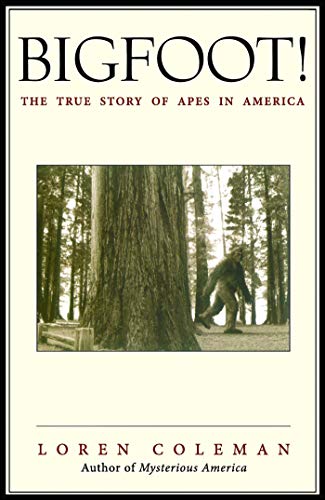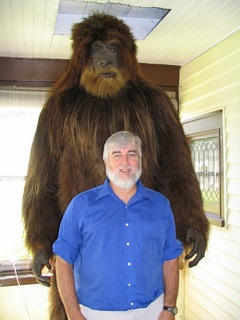
I’ve been interested in “Bigfoot” since I was a kid and saw the Patterson-Gimlin film of a female Bigfoot casually walking by a creek. In fact, deep in Oregon’s coast range my friend and I were screamed at repeatedly by a large animal – but more on that later.
So of course I began to follow author Loren Coleman on Twitter, and eventually had a few on-line exchanges with him. I had requested a suggestion for a Bigfoot book, and he gave me a few. However, another person on the thread said I should start by reading Coleman’s own book, “Bigfoot! – The True Story Of Apes In America”.
Of course, I thought. I should have checked Mr. Coleman’s catalog first, and I got a copy of this book.
Believe me, I was not disappointed, in fact it was a quick, informative read and quite a romp as well!
This was a good entry book on the subject for me. Coleman writes in narrative and stays away from many of the unlimited scientific details that experts argue over. After reading the accounts in this book, I am now more than ever convinced there have been and still are large apes in North America.
There is simply no way that the wide-spread sightings of the creature, many dating far back in history, have been hoaxes.
With that said, Coleman does examine which cases could have been pranks (for financial scams), and those which simply have no explanation other than an actual sighting.
Bigfoot country has always been just out my backdoor. When I was a teen, I crawled through the famous “Ape Cave”, near Ape Canyon where a remote cabin was attacked by such creatures a hundred-years earlier.
Additionally, I met Ray Crowe who ran a Bigfoot research group. I used to regularly visit Crowe’s bookstore in sleepy St. Johns, on the edge of Portland Oregon. I told him of my possible Bigfoot experience and he dutifully dated it and marked it on his map. He also showed me locations of similar reports in the same area.

Loren Coleman and a friend
But back to Coleman’s “Bigfoot!”.
Coleman covers the early legends as told by Native Americans, including those of kidnapping and cannibalism. The timeline reaches through the arrival of white settlers to the 1950’s when cameras were used to capture Bigfoot images. The most famous being The Patterson-Gimlin 1967 film, which many have seen. Of course, the film depicts a huge female Bigfoot looking over it’s shoulder as it eases out of view into the woods. Coleman examines skeptical criticism of the film, but serious scientists have come to believe it was an authentic sighting. Coleman also suggests that there is simply no way the hundred-years of track evidence could have been hoaxed.
Additionally, Coleman goes into detail regarding the differences in sightings and creature development from West Coast to East Coast. This is part of the science I was unaware of. Coleman sites case after case of eastern and southern sightings of what may be a distantly related animal, that may be even more aggressive.
Southern and Eastern Bigfoot are found to have toes that have an “opposing thumb” (like jungle apes) while the Western Bigfoot has forward pointing toes like humans.
Bigfoot is not the only character in the story. Coleman introduces us to the back-country Bigfoot hunters, the anthropologists, the colorful European researchers, and the adventurers who trekked through Asia to search for “The Yeti”.
Coleman also discusses the emergence of Bigfoot into modern culture, from decorative Bigfoot fruit-packing boxes to movies like “Harry and The Hendersons”.
And not to be left out, Coleman writes a chapter on a Bigfoot taboo; “Sex and the Single Sasquatch”.
This chapter is both funny and curious, as Coleman questions why there are so few descriptions of Bigfoot genitalia. There are however, stories of lonely Bigfoot having sex with cows, as well as sightings of young individuals with older Bigfoot adults. This clearly indicates reproduction and family or tribal structure.
We also consider the question of whether it would be legal or ethical to shoot a Bigfoot to prove it’s existence.
“Bigfoot!- The True Story Of Apes In America” was a great introduction to the world of Bigfoot research. It is loaded with resources for further inspection, and a lengthy bibliography of research and sightings. I really, really enjoyed this book and will continue to read up on the subject.
Loren Coleman runs a museum of “Cryptozoology” in Portland, Maine, and can be found on Twitter @CryptoLoren
For those who want to hear about my possible Bigfoot experience, Here’s the link to a 2013 article I wrote: https://www.covertbookreport.com/my-bigfoot-story-2/https://www.covertbookreport.com/my-bigfoot-story-2/
-John Titus

